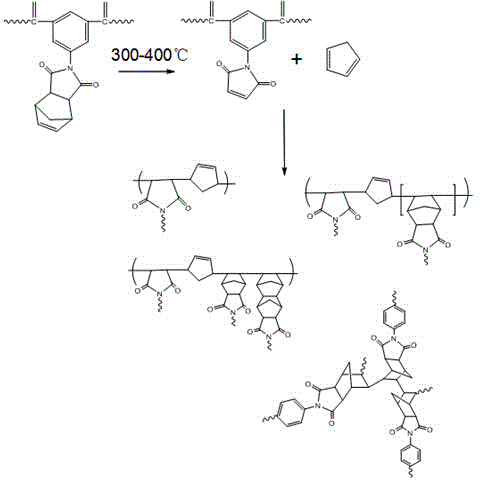Copolyester crosslinking monomer, copolyester based on monomer and preparation method thereof
A technology of cross-linking monomers and copolyesters, applied in the direction of organic chemistry, etc., can solve the problems of undiscovered copolyester glass ring transition temperature, limited combustion effect, complex synthesis, etc., to achieve high glass transition temperature and low cost , The effect of simple synthesis process
- Summary
- Abstract
- Description
- Claims
- Application Information
AI Technical Summary
Problems solved by technology
Method used
Image
Examples
Embodiment 1
[0051] 55.3g dimethyl terephthalate, 40.9g ethylene glycol, 5.3g 5-(norbornene-2,3-dicarboxyimino)-1,3-dimethylisophthalate (DMTMI ), 0.061g of zinc acetate and 0.061g of tetrabutyl titanate were added to the polymerization bottle, filled with nitrogen to remove the air in the polymerization bottle; within 2 hours, the temperature was raised to 180°C to start the esterification reaction, and at the same time, nitrogen was kept flowing for 3 After 1.5 hours, the temperature was gradually raised to 200°C, 220°C, and 240°C, and the esterification reaction was completed; thereafter, the polycondensation reaction was carried out at 240-260°C in low vacuum (400Pa~100Pa) for 0.5 hours, and then the temperature was raised to 260°C ℃~270℃ high vacuum (pressure <60Pa) polycondensation reaction for 1~3 hours, the target product can be obtained. In the resulting product, DMTMI accounted for 5% by mole of the dibasic acid structure.
[0052] The intrinsic viscosity [η] of the polyester is...
Embodiment 2
[0054] 52.5g dimethyl terephthalate, 40.9g ethylene glycol, 10.7g 5-(norbornene-2,3-dicarboxyimino)-1,3-dimethylisophthalate (DMTMI ), 0.062g of zinc acetate and 0.062g of tetrabutyl titanate were added into the polymerization bottle, and the target product was obtained after esterification reaction and polycondensation were carried out according to the steps and conditions given in Example 1. In the resulting product, DMTMI accounted for 10% of the mole percent of the dibasic acid structure.
[0055] The intrinsic viscosity [η] of the polyester is 0.62 dL / g; the oxygen index is 27.7%, the glass transition temperature is 89.5°C, and the peak heat release rate p-HRR in the cone calorimetry test is 525 kW / m 2 .
Embodiment 3
[0057] 46.7g dimethyl terephthalate, 40.9g ethylene glycol, 21.4g 5-(norbornene-2,3-dicarboxyimino)-1,3-dimethylisophthalate (DMTMI ), 0.064g of zinc acetate and 0.052g of tetrabutyl titanate were added into the polymerization bottle, and the target product was obtained after esterification reaction and polycondensation were carried out according to the steps and conditions given in Example 1. In the resulting product, DMTMI accounted for 20% of the mole percent of the dibasic acid structure.
[0058] The intrinsic viscosity [η] of the polyester is 0.60 dL / g; the oxygen index is 26.0%, the glass transition temperature is 98.6°C, and the peak heat release rate p-HRR in the cone calorimetry test is 268kW / m 2 .
PUM
| Property | Measurement | Unit |
|---|---|---|
| Intrinsic viscosity | aaaaa | aaaaa |
| Glass transition temperature | aaaaa | aaaaa |
| Intrinsic viscosity | aaaaa | aaaaa |
Abstract
Description
Claims
Application Information
 Login to View More
Login to View More - R&D
- Intellectual Property
- Life Sciences
- Materials
- Tech Scout
- Unparalleled Data Quality
- Higher Quality Content
- 60% Fewer Hallucinations
Browse by: Latest US Patents, China's latest patents, Technical Efficacy Thesaurus, Application Domain, Technology Topic, Popular Technical Reports.
© 2025 PatSnap. All rights reserved.Legal|Privacy policy|Modern Slavery Act Transparency Statement|Sitemap|About US| Contact US: help@patsnap.com



